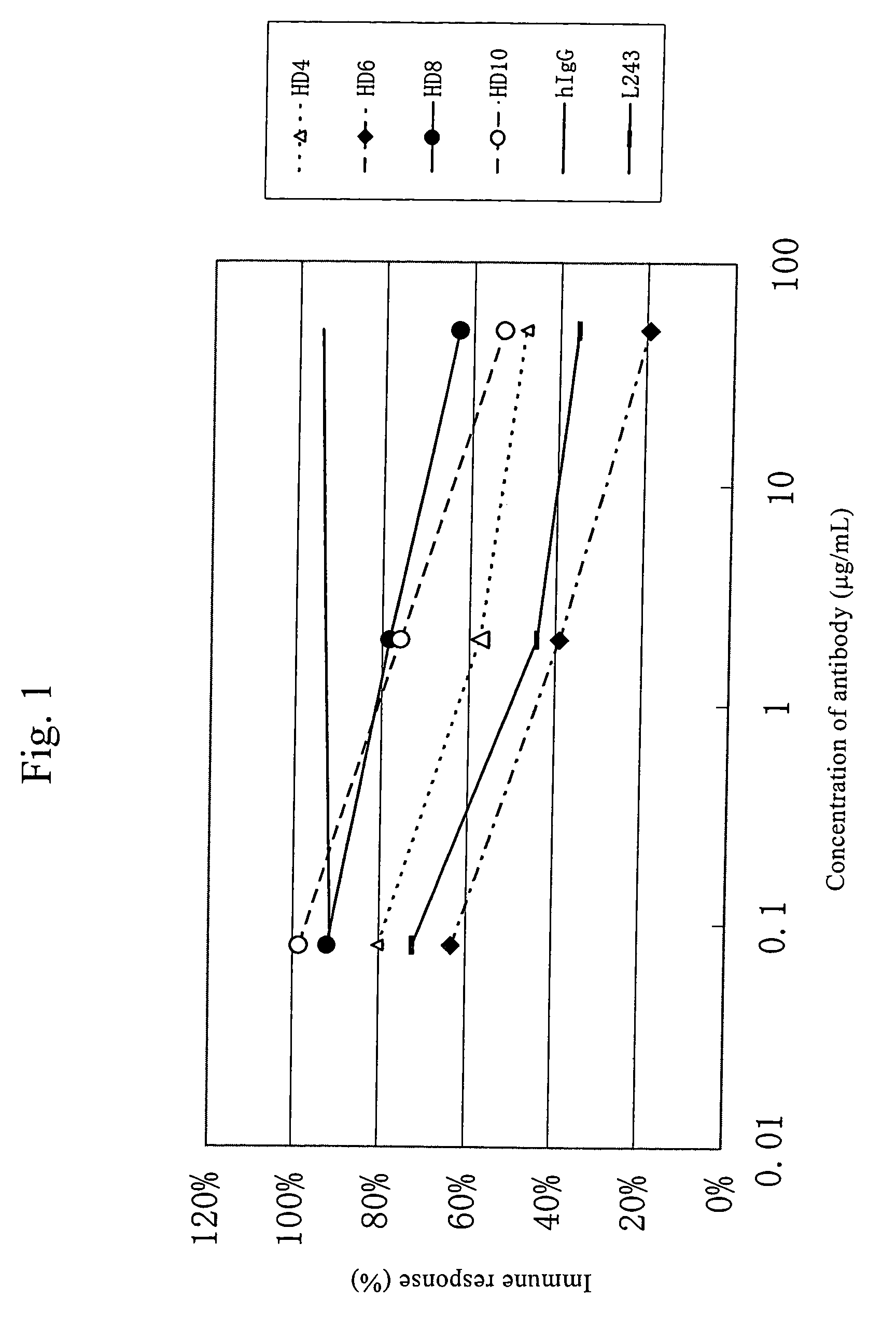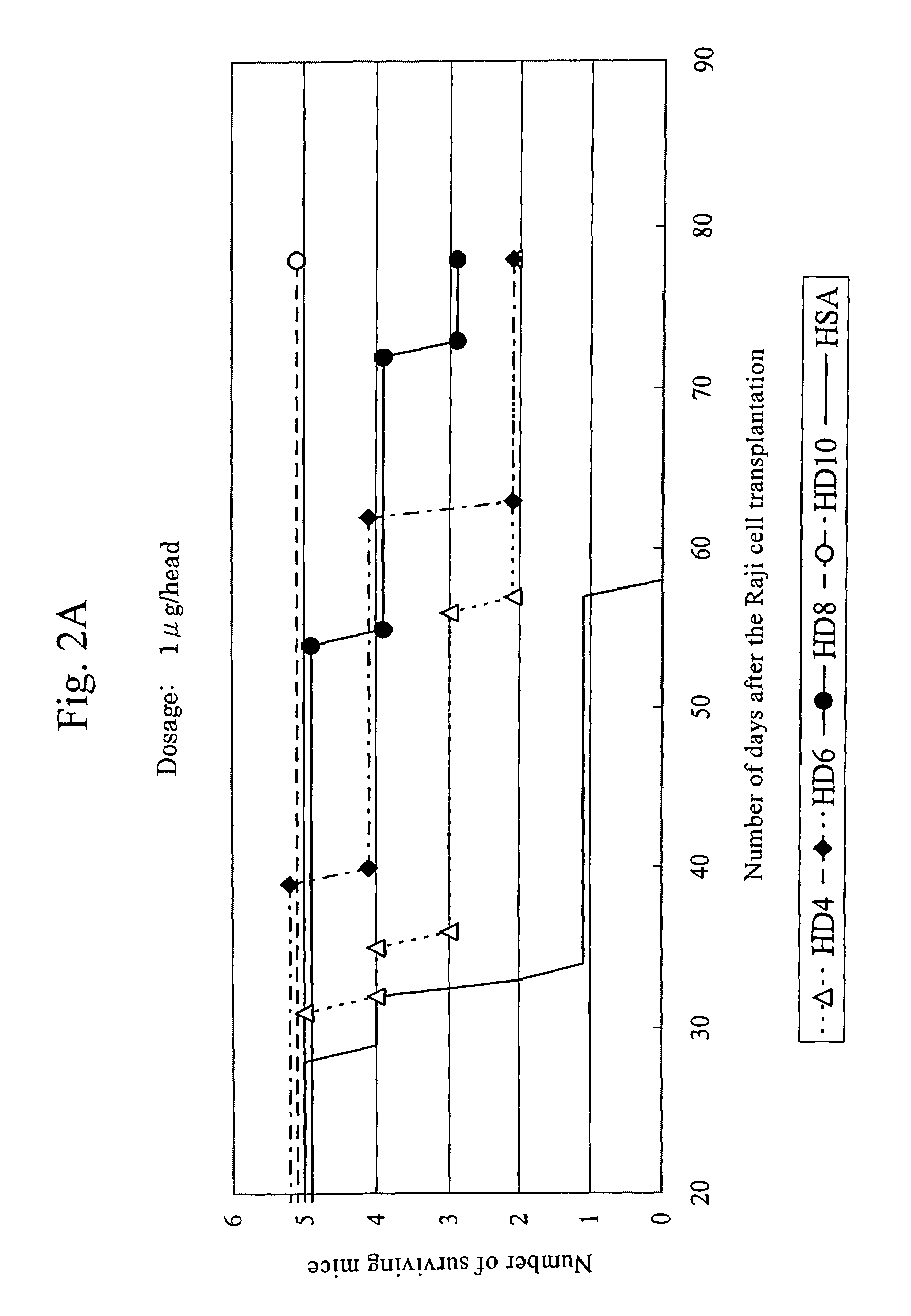Anti-HLA-DR antibody
a technology of anti-hladr antibody and antibody, which is applied in the field of anti-hladr antibody, can solve the problems of tumor-specific antibodies, limited side effects, arrest or regression of tumor growth, etc., and achieve the effect of suppressing the survival ratio of tumor-bearing mouse models and the survival ratio of mi
- Summary
- Abstract
- Description
- Claims
- Application Information
AI Technical Summary
Benefits of technology
Problems solved by technology
Method used
Image
Examples
example 1
Preparation of Antigen
[0119]In order to obtain a cell having excessively expressed human HLA-DR on its cell membrane, plasmid vectors for the expression of full-length amino acids in the human HLA-DR α chain and β chain were prepared. DNA encoding the HLA-DR α chain and β chain was prepared by PCR.
a) Preparation of Expression Vectors for Full-length Human HLA-DR α Chain and β Chain
[0120]In template PCR, plasmid vectors pEF-neo-HLA-DRα and pEF-neo-HLA-DRβ holding cDNA encoding the human HLA-DR α chain and β chain were used as the templates. pEF-neo-HLA-DRα and pEF-neo-HLA-DRβ were prepared in the manner as described below. DNA of the full-length human HLA-DR α chain and that of the HLA-DR β chain were modified by the polymerase chain reaction (PCR) for adding the EcoRI sequence at the 5′-terminus and the NotI sequence and a stop codon at the 3′-terminus. PCR was carried out for 30 PCR cycles of 94° C. for 15 seconds, 55° C. for 30 seconds, and 72° C. for 60 seconds using, as a templa...
example 2
Preparation of Human Antibody-producing Mouse
[0123]The mouse used for immunization is genetically homozygous for both endogenous Ig heavy chain breakdown and κ light chain breakdown, and simultaneously retains a chromosome 14 fragment (SC 20) containing a human Ig heavy chain locus and a human Igκ chain transgene (KCo5). This mouse was prepared by mating a mouse having a human Ig heavy chain locus (lineage A) with a mouse having a human Igκ chain transgene (lineage B). Lineage A is homozygous for both endogenous Ig heavy chain breakdown and κ light chain breakdown, and retains a chromosome 14 fragment (SC20) that is transmittable. For example, it is described in the report by Tomizuka et al. (Tomizuka et al., Proc. Natl. Acad. Sci. USA, 2000, Vol. 97: 722). Lineage B is homozygous for both endogenous Ig heavy chain breakdown and κ light chain breakdown, and retains a human Igκ chain transgene (KCo5, a transgenic mouse). It is described for example, in the report by Fishwild et al. (...
example 3
Preparation of Human Monoclonal Antibody Against Human HLA-DR
[0125]In this example, a monoclonal antibody was prepared in accordance with a common technique as described in, for example, “Tan-kuron koutai jikken sousa nyuumon (A guide to monoclonal antibody experiments)” (Tamie ANDO et al., Kodansha Ltd. Publishers, 1991). The HLA-DR-expressing L929 cell prepared in Example 1 was used as the immunogen human HLA-DR. A human immunoglobulin-producing human antibody-producing mouse prepared in Example 2 was used as an animal to be immunized.
[0126]In order to prepare a human monoclonal antibody against human HLA-DR, human antibody-producing mice were subjected to initial immunization intraperitoneally with the HLA-DR-expressing L929 cells (5×106 cells per mouse) prepared in Example 1. After the initial immunization, the same cells were administered for immunization 2, 4, and 8 weeks later. Three days before obtaining the spleen and the lymph node as described below, cells (1×106 cells pe...
PUM
 Login to View More
Login to View More Abstract
Description
Claims
Application Information
 Login to View More
Login to View More - R&D
- Intellectual Property
- Life Sciences
- Materials
- Tech Scout
- Unparalleled Data Quality
- Higher Quality Content
- 60% Fewer Hallucinations
Browse by: Latest US Patents, China's latest patents, Technical Efficacy Thesaurus, Application Domain, Technology Topic, Popular Technical Reports.
© 2025 PatSnap. All rights reserved.Legal|Privacy policy|Modern Slavery Act Transparency Statement|Sitemap|About US| Contact US: help@patsnap.com



